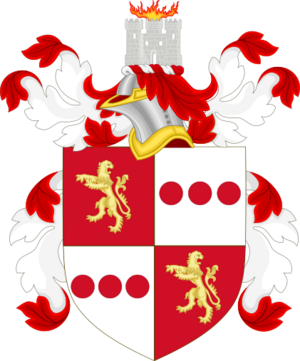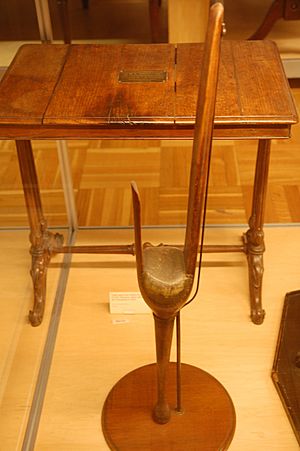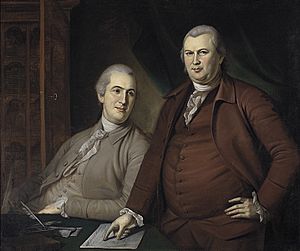Gouverneur Morris facts for kids
Quick facts for kids
Gouverneur Morris
|
|
|---|---|
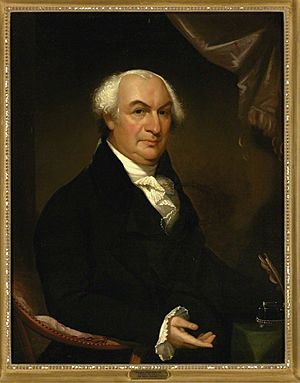 |
|
| United States Senator from New York |
|
| In office April 3, 1800 – March 3, 1803 |
|
| Preceded by | James Watson |
| Succeeded by | Theodorus Bailey |
| 4th United States Minister to France | |
| In office June 3, 1792 – April 9, 1794 |
|
| President | George Washington |
| Preceded by | William Short |
| Succeeded by | James Monroe |
| Personal details | |
| Born | January 31, 1752 Province of New York, British America |
| Died | November 6, 1816 (aged 64) New York, U.S. |
| Resting place | Saint Ann's Episcopal Church, The Bronx |
| Political party | Federalist |
| Spouse | |
| Children | Gouverneur Morris II |
| Alma mater | King's College (BA, MA) |
Gouverneur Morris (January 31, 1752 – November 6, 1816) was an important American leader and one of the Founding Fathers of the United States. He helped create the new country by signing both the Articles of Confederation and the U.S. Constitution. He is famous for writing the Preamble to the United States Constitution, which is the introduction to the Constitution. Because of this, he is often called the "Penman of the Constitution."
Morris believed that Americans should think of themselves as citizens of one big country, not just their individual states. He was also one of the strongest voices against slavery at the meeting where the Constitution was written. He served as a United States Senator for New York from 1800 to 1803.
Morris was born into a rich family in what is now New York City. He went to King's College (now Columbia University) and became a lawyer. He was elected to the New York Provincial Congress and then served in the Continental Congress. Later, he helped manage the country's money as the assistant U.S. Superintendent of Finance. He represented Pennsylvania at the 1787 Constitutional Convention, where he argued for a strong central government.
After the Constitution was approved, Morris became the U.S. ambassador to France. He returned to the United States in 1798 and was elected to the Senate in 1800. After leaving the Senate, he led the Erie Canal Commission, which helped build an important canal in New York.
Contents
Who Was Gouverneur Morris?
Early Life and Family History
Gouverneur Morris was born on January 31, 1752. His father was Lewis Morris Jr., and his mother was Sarah Gouverneur. His first name, Gouverneur, came from his mother's family name. They were Huguenots, a group of French Protestants, who had moved from France to Holland and then to America. In both Dutch and French, "Gouverneur" means "Governor."
Morris had many family members who were important in American history. His half-brother, Lewis Morris, signed the Declaration of Independence. Another half-brother, Staats Long Morris, fought for the British during the American Revolution. His grandfather, Lewis Morris, was a chief judge in New York and a British governor of New Jersey.
Gouverneur Morris grew up on his family's large estate called Morrisania, which is now part of The Bronx in New York City. He was a very smart student. He started King's College (now Columbia University) when he was just 12 years old. He earned his first degree in 1768 and a master's degree in 1771. He then studied law and became a lawyer in 1775.
Gouverneur Morris's Career
Early Political Steps
On May 8, 1775, Morris was chosen to represent his area in the New York Provincial Congress. As a member, he worked with others to make New York an independent state. This decision caused some disagreements with his family and his teacher, William Smith, who did not support independence. Morris also served in the New York State Assembly from 1777 to 1778.
After the British took over New York City in 1776, Morris's mother, who supported the British, allowed them to use their family estate for military purposes.
Serving in the Continental Congress
Morris became a delegate to the Continental Congress on January 28, 1778. He joined a special committee that worked with George Washington to improve the military. After seeing the difficult conditions of the soldiers at Valley Forge, he spoke up for the Continental Army in Congress. He helped make important changes to how the army was trained, organized, and funded. In 1778, he also signed the Articles of Confederation, becoming the youngest person to do so.
During a time when some members of Congress wanted to remove George Washington as the army's leader, Gouverneur Morris cast the deciding vote to keep Washington in charge.
Life as a Lawyer and Merchant
In 1779, Morris was not re-elected to Congress. This was mainly because he wanted a strong central government, which was different from what many people in New York wanted at the time. After this, he moved to Philadelphia, Pennsylvania, to work as a lawyer and merchant.
In 1780, Morris was in a carriage accident in Philadelphia and lost his left leg below the knee. Even though he had this injury and had served in government, he still joined a special group to help protect New York City.
Helping Write the U.S. Constitution
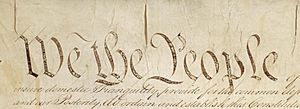
In Philadelphia, Morris became the assistant superintendent of finance for the United States, working under Robert Morris. In 1787, he was chosen to represent Pennsylvania at the Constitutional Convention. At this meeting, he was a close friend and supporter of George Washington and others who wanted a strong central government.
Morris was chosen for the Committee of Style and Arrangement, a group of five people who wrote the final version of the proposed Constitution. Many historians believe that Morris did most of the writing and polishing of the document. He is often called the "Penman of the Constitution" because of his important role.
Morris believed that a strong government was needed. He gave more speeches than any other delegate at the Convention, a total of 173. He strongly supported the right for everyone to practice their chosen religion freely and argued for this idea to be included in the Constitution.
Opposing Slavery
Gouverneur Morris was one of the few delegates at the Philadelphia Convention who openly spoke against domestic slavery. According to James Madison's notes from the Convention, Morris said on August 8, 1787, that it made no sense to say that a slave was both a person and property at the same time.
Morris believed that slavery was a terrible practice. He felt it brought shame to the country and would lead to future problems. He argued that the government should not support slavery in any way.
Ambassador to France
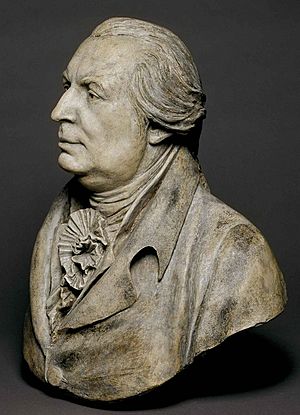
Morris traveled to France for business in 1789. From 1792 to 1794, he served as the U.S. ambassador to France. His personal journals from this time are very important because they describe the French Revolution and its violence. Morris was much more critical of the French Revolution than Thomas Jefferson was. He also felt more sympathy for the queen, Marie Antoinette.
Morris was the only foreign representative who stayed in France during the most dangerous period of the revolution, known as the Reign of Terror. Once, when a hostile crowd threatened to hang him, he took off his wooden leg, waved it, and announced that he was an American who had lost a limb fighting for liberty. The crowd's anger turned into cheers.
While Morris was ambassador, the Marquis de Lafayette, who helped in the American Revolution, was forced to leave France, and his family was put in prison. Thomas Paine, another important figure, was arrested and imprisoned in France. Morris's efforts to help them have been seen by some as not strong enough. After Morris was replaced as ambassador, his successor, James Monroe, helped secure Paine's release.
Serving in the U.S. Senate
Morris returned to the United States in 1798. In April 1800, he was elected as a Federalist to the U.S. Senate. He filled a vacant seat and served from May 3, 1800, to March 3, 1803. He was not re-elected in February 1803.
Later Contributions
After leaving the Senate, Morris continued to serve the public. From 1810 to 1813, he was the Chairman of the Erie Canal Commission. The Erie Canal was a huge project that helped make New York City a major financial center. Morris believed that America would become a very powerful nation.
He was also one of three men who created the Commissioners' Plan of 1811, which designed the street layout for Manhattan. Morris's last public act was to support the Hartford Convention during the War of 1812. He even suggested that New York and New England might separate from the rest of the country because he believed the war was caused by slaveholders wanting more land.
Personal Life
In 1809, when he was 57 years old, Gouverneur Morris married 35-year-old Ann Cary Randolph, who was known as "Nancy." Their marriage was a happy one. They had a son named Gouverneur Morris Jr., who later became a successful railroad executive.
Death and Legacy
Morris passed away on November 6, 1816, at his family estate, Morrisania. He was buried at St. Ann's Church in The Bronx.
Morris's great-grandson, also named Gouverneur Morris (1876–1953), became a writer of popular novels and short stories in the early 20th century. Some of his stories were even made into movies.
Several places in northern New York are named after Gouverneur Morris, including the Town of Gouverneur, the Village of Gouverneur, and the Village of Morristown in St. Lawrence County. In 1943, a United States Liberty ship, the SS Gouverneur Morris, was named in his honor.
Images for kids
See also
 In Spanish: Gouverneur Morris para niños
In Spanish: Gouverneur Morris para niños
- France–United States relations


